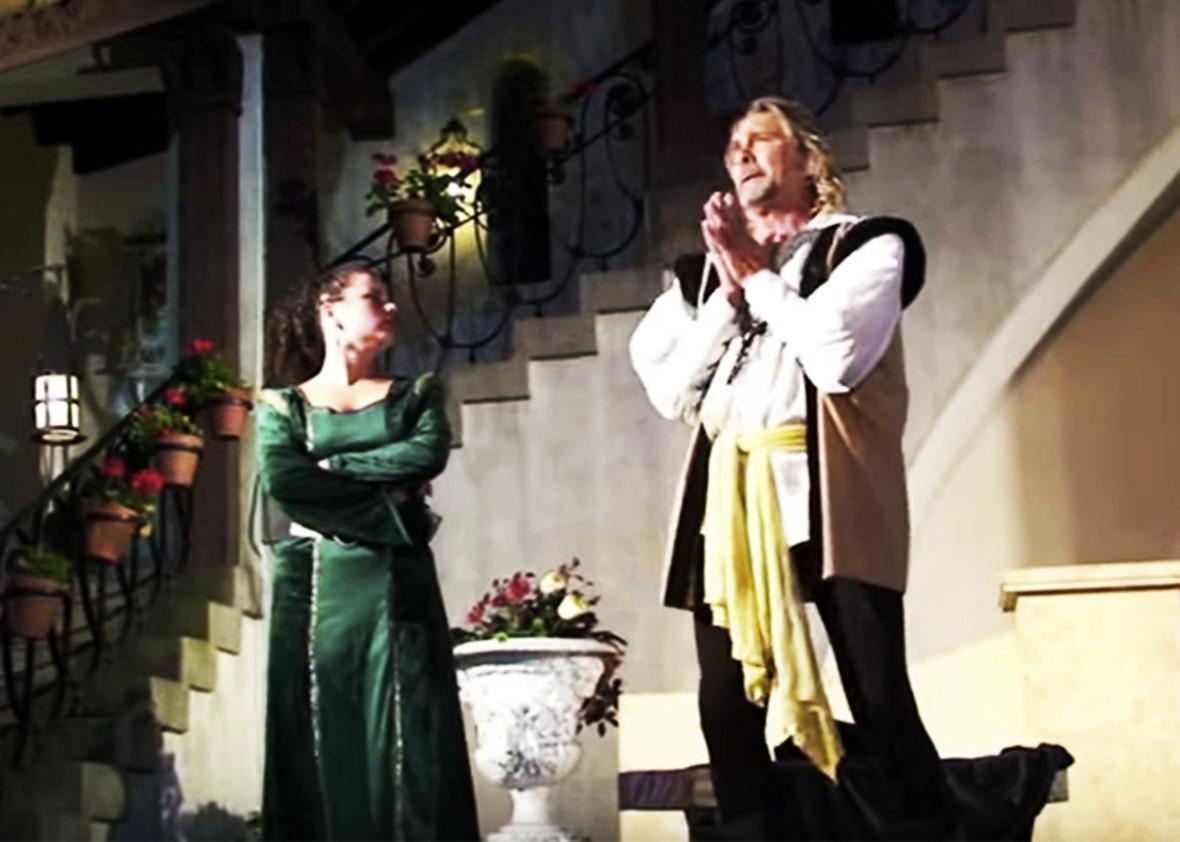This post originally appeared on Strong Language, a sweary blog about swearing.
“ … She did call me rascal, fiddler, / And twangling jack, with twenty such vile terms,” a beaten-up Hortensio cries after a rough music lesson with the titular “shrew,” Katherine, in Shakespeare’s The Taming of the Shrew (2.1.155-6). To the delight of Strong Language readers, the comedy gives us much more than 20 vile terms. And I think they still have a lot of vim and vigor today.
I reread the play recently for part of a project I’m calling Shakespeare Confidential. During my reading, I tracked instances of strong language. With its rogues and villains,wenches and wildcats knaves and nits, and asses and swains, The Taming of the Shrew kept my pen busy. No pun intended.
To be clear, the characters’ disguises and dissembling throughout the comedy raise important questions about gender and social identity that are incredibly relevant in 2016. (Click here for a synopsis of the play.) The Bard’s own strong language adds to the complexity of these themes, of course. For instance, Gremio, an older suitor of Bianca, calls Katherine a “fiend of hell” (1.1.88) and bids her go to the “devil’s dam” (1.1.105). Men of the play certainly face some strong language, but none are quite demonized, by my reckoning.
We can and should debate whether The Taming of the Shrew reinforces or challenges traditional power hierarchies, including how Shakespeare uses language to do so. But here, I want to honor this enduring comedy by celebrating some great moments in its strong language. I know, there’s no shit or fuck, but this shit’s fucking good.
When Katherine and Petruccio first meet, they engage in a repartee delightfully dense with sexual puns (2.1.207-15):
Petruccio: Come, come, you wasp, i’fath you are too angry.
Katherine: If I be waspish, best beware my sting.
Petruccio: My remedy is then to pluck it out.
Katherine: Ay, if the fool could find it where it lies.
Petruccio: Who knows not where a wasp does wear his sting? In his tail.
Katherine: In his tongue.
Petruccio: Whose tongue?
Katherine: Yours, if you talk of tales, and so farewell,.
Petruccio: What, with my tongue in your tail? Nay, come again, Good Kate, I am a gentleman.
Katherine: That I’ll try.
Sting, tail? Eh, eh? This war of wits displays a level of linguistic creativity matched only by the wordplay I used to hear when I taught in public schools. Shakespeare doesn’t even explicitly use any taboo words for genitals (whether mild like penis or strong like cunt), but this scene is pure genius in my book.
(A quick aside: The Taming of the Shrew is dated to at least 1592, while the slang sense of come for “orgasm” is attested by 1650, as Iva Cheung discussed. Perhaps the modern reader gets to add to the sexual tension?)
But for all Kate’s supposed shrewishness, it’s Petruccio who really throws some shade. To tame Katherine, for a refresher, Petruccio “kills her in her own humour” (4.1.161) and “kills [her] with kindness” (4.1.189). For example, immediately following their nuptials, he deprives Katherine of food, laying into his servants for dishing up food he pretends is not good enough for her—all as a way to make an example of her nasty temper. That’s pretty fucked up, but it does leave us with some truly memorable vituperations (and these in the first scene of Act 4 alone):
- “You logger-headed and unpolished grooms” (4.1.106)
- “You peasant swain, you whoreson, malthorse drudge” (4.1.110)
- “A whoreson, beetle-headed, flap-eared knave” (4.1.138)
- “You heedless jolt-heads and unmannered slaves” (4.1.147)
I could gloss some of these expressions, but I think the meaning comes across loud and clear 400 years after Bill kicked the bucket. (OK, “logger-headed,” “beetle-headed,” and “jolt-head,” as you might have guessed, are all calling the servants stupid, in essence. A “swain” was a farm worker and a “whoreson” a bastard. A “malthorse,” a lug of a horse, ground up malt.)
Of course, we’re no strangers to such splenetic strings today, especially the more callow or creative cursers among us, you no-good, two-timing, rat-titted, cunt-faced bastards, you. These strings can be playful. They can pack extra punch. They can even push the envelope. And if Shakespeare did it, well then …
So, if you’re looking for some choice words, take a page from Petruccio’s playbook: Add some color, er, choler. Just avoid this whole “taming” and “shrew” business.
Thanks, as always, to Stan Carey for “Great Moments in Swearing,” as well as to Heather Froehlich, whose has analyzed Shakespeare’s language, especially the strong stuff, with respect to gender.
